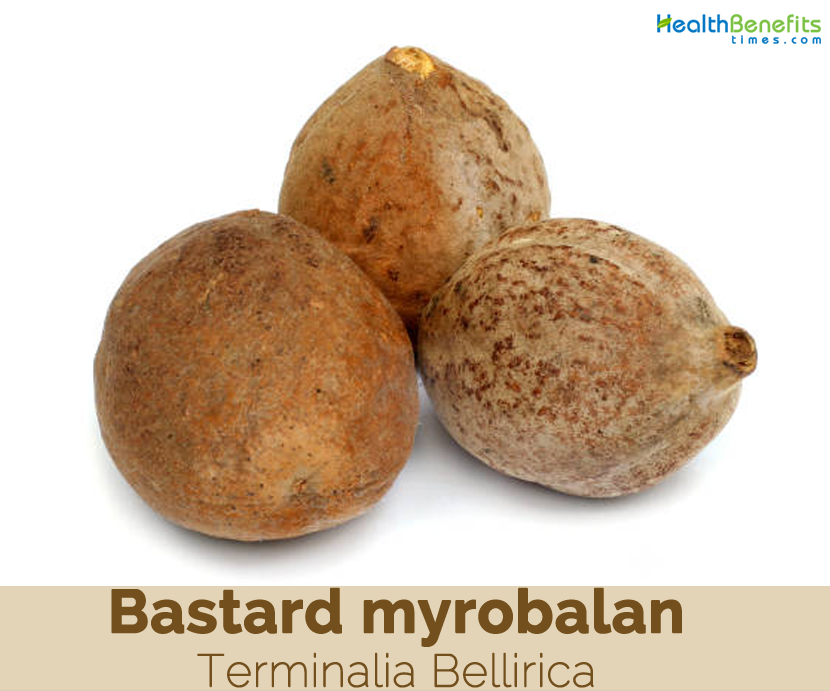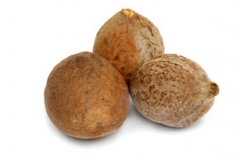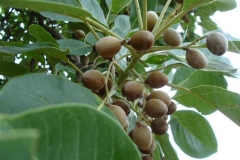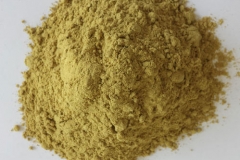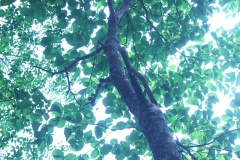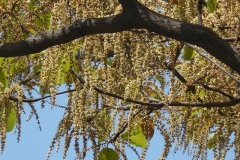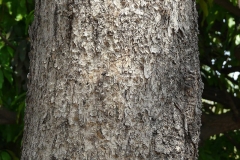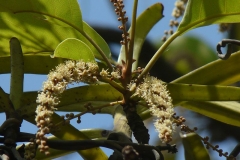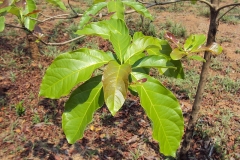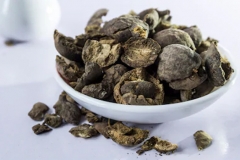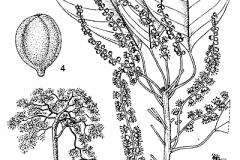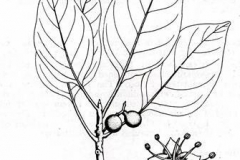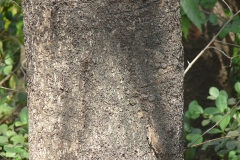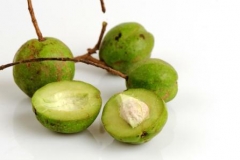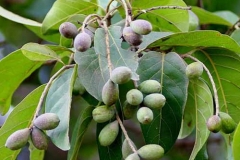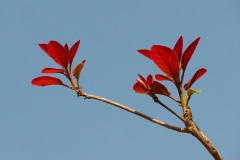| Bastard myrobalan Quick Facts |
| Name: |
Bastard myrobalan |
| Scientific Name: |
Terminalia Bellirica |
| Origin |
Tropical Asia such as India, Sri Lanka, Nepal, Bhutan, Pakistan, Malaysia, Indonesia and China |
| Colors |
Grey color |
| Shapes |
Nearly globose to broadly ellipsoid drupe 2–3.5 cm long, with 5 longitudinal ridges, densely short-hairy. |
| Taste |
Acrid, sweet, astringent |
| Health benefits |
Help in Weight Loss, Helpful in Constipation, Get Rid Of Headache, Treat Diarrhea, Prevents Cough and Cold, Soothe Sore Throat, Heals Wounds, Removes Acne and Ulcers, Dental Problems, Treat Indigestion, Prevents Hair Loss, Treatment for Loss of Appetite, |
Terminalia bellerica commonly known as Baheda or Bibhitaki is one of the important herbs of Ayurvedic medicine. It is a medicinal deciduous tree of the Combretacea family native to tropical Asia such as India, Sri Lanka, Nepal, Bhutan, Pakistan, Malaysia, Indonesia and China. In India, it is mostly found in the plain dry forests of Tamil Nadu, Assam, Odisha, Gujarat, Andhra Pradesh and Kerala. Few of the popular common names of the plant are Bastard Myrobalan, Barro, Bedda Nut Tree, Thani, Thandri, Baheda, Beleric Myrobalan, Bolsuiri, Belliric Myrabolan, Beach Almond, Agong, Behere and Belleric. The generic name ‘Terminalia’ comes from Latin word ‘terminus’ or ‘terminalis’ (ending), and refers to the habit of the leaves being crowded or borne on the tips of the shoots. Bibhitaki, which means fearless, is the Sanskrit name for Terminalia bellerica.
Baheda is a fruit that is used as traditional remedy in various parts of India for mind-altering element; they used as the remedy by smoking dried kernels. Different parts of Baheda plants are used in the folk system of medicines like Ayurveda, Unani, Siddha and Chinese medicine. In Asia, the uses of remedial plants are well-established and are well recorded. It is an important part of Triphala churna which is composed of a blend from the dried fruits of Amalaki (Emblica Officinalis), Bibhitaki (Terminalia Bellirica) and Haritaki (Terminalia Chebula) with amazing healing properties in appropriate proportion.
Plant description
Baheda is a large, fast-growing deciduous tree that grows about 12-50 m tall and a diameter of 3 m and looks like a rounded crown. It is customarily buttressed trunk near the base, and its branchless are up to 20 m long. The plant is found growing in scattered forests, sunny mountain slopes, upper layer trees of stream valleys, lower seasonal rain forests, monsoon forests, mixed deciduous forests or dry deciduous dipterocarp forests, associated with teak. The plant grows best on fertile, loam soils with good drainage; however, it has performed reasonably well on poor soils where the choice of tree species is limited. Bark is 10-20 mm thick, bluish or ashy-grey covered with numerous fine longitudinal cracks and yellowish inner bark. Twigs are thick, initially densely short-hairy.
Leaves
Leaves are large, glabrous, alternate, broadly elliptic to obovate-elliptical, 8-20 cm long and 7.5-15 cm wide, base rounded to cuneate, rufous-sericeous but soon glabrescent, with 6-9 pairs of secondary veins. Secondary and tertiary venation prominent on both surfaces, clustered towards the ends of branchlets. Leaf tip is narrow- pointed or rounded. Petiole is 2.5-9 cm long. Young leaves copper-red, soon becoming parrot green, then dark green. It is considered a good fodder for cattle.
Flower & Fruit
Flowers are solitary, small, 3-15 cm long, 5-6 mm across, stalk less, greenish white, simple, axillary spikes; calyx tube densely sericeous or tomentulose; flowers appear along with new leaves and have a strong honey-like smell. Upper flowers of the spike are male, lower flowers are bisexual. Stamens are 3-4 mm long. Flowering normally takes place from March-May. Fertile flowers are followed by sub-globular to broadly ellipsoid drupe, 2–3.5 cm long, densely velutinous or sericeous, and light-yellow, obscurely 5-angled and minutely brown tomentosa.
Fruit is covered with minute pale pubescence. Oil obtained from the seed is useful in Skin diseases. It is a good tonic for stomach and brain. It is an effective for headache, chronic diarrhea and piles. It is useful in treating bronchitis, nose and heart disease. The tree sheds leaves in November with young ones appearing together with flowers. Animals eat fruits, thus dispersing the seeds.
Health Benefits of Baheda powder
Bibhitaki, the wonder medicine has several health benefits, some of them are mentioned below:
1. Help in Weight Loss
Baheda fruit can be a best option for the people trying to lose weight. Ayurvedic principles say that the herbs which have an astringent taste tend to shrink fat tissues. Baheda has astringent taste and is light to digest and causes dryness of tissues.
Besides this, it is hot potency in nature. So that person seeking for losing belly fat or weight loss can shrink the fat tissues using this herb. As Baheda fruit is light to digest it boosts body fire the increased body fire accelerates metabolism and turns metabolism accumulated fat. Taking Baheda churna daily can regulate hunger and combined with well-balanced diet and routine exercise will aid in weight loss naturally.
2. Helpful in Constipation
Baheda is one of the important plants of Ayurveda that has been traditionally used to relieve constipation. It has a natural laxative property and holds in dietary fibers, a digestive agent who fights with constipation. Consuming Baheda churna can have soothing and lubricating effect on the gastro enteric tract. Besides this, it additionally heals and nourishes intestinal tract and beneficial to persons suffering from other digestive complaints such as stomach cramps or IBS.
3. Get Rid Of Headache
Baheda churna can be quite beneficial for relieving headache pain. Take Baheda and jawasa and make decoction from it add 1 teaspoon of ghee to it. Give this decoction to a person suffering from headache, three times a day. This decoction will help to cure headache caused due to pitta and will also cure fevers as well as dizziness.
4. Treat Diarrhea
Diarrhea is a sign that your body is trying to rid itself of something toxic or something unhealthy things in your system. The situation can be controlled by herbal remedy made from baheda plant. Take 2-5 gm. of bark of baheda tree and 1-2 cloves, grind them well and add one teaspoon of honey into it. Consume this remedy for three to four times a day sooner you will find loose motion is under control.
5. Prevents Cough and Cold
Baheda is very effective herb in treating respiratory disorders, and problems caused due to cold. In Ayurveda the herb is known to reduce the cough, releases the mucus and clear air passages. It also smooth the bronchial spasms and allow the patient to breathe freely.
Furthermore, the fruit, gives an excellent cholagogic effect, that can restore the cough reflex. Besides this, it is also beneficial in gingivitis, a common infection within the mouth and gums. The main symptoms are mouthed or gum swelling, result in due to viral or bacterial infection.
6. Soothe Sore Throat
Sore throat is a swollen throat that produces pain when swallowing. For this ailment baheda can be best option. Take a baheda, pound on it using a stone, you will find a single seed inside, remove it. Next take one of the broken shells and suck it, it will taste as an astringent and bitter, but it works well for sore throat and cough.
7. Heals Wounds
Baheda paste is an amazing wound healer. If you are suffering from minor rashes, skin irritations, apply a paste of baheda. For the paste, take a small piece of baheda and rub it on a stone along with little water to get a smooth paste.
8. Removes Acne and Ulcers
Baheda Fruit has many medicinal benefits and antibacterial properties, which can make the scars, vanish away. Vitamin C and minerals such as potassium, selenium, iron, copper and manganese helps to smooth the skin and helps to reduce inflammation.
Besides this, it consists of powerful antioxidants that are very helpful for maintaining the health and appearance to the skin. The anti-inflammatory and antiseptic properties of these seeds on the skin help to diminish acne scars and heal other skin conditions.
9. Dental Problems
Decoction made by boiling the shell of the broken fruit along with little water can be used as a mouth rinse and it will treat most of the dental problems like mouth odor, mouth ulcers, etc.
10. Treat Indigestion
The ordinary signs of indigestion such as abdominal pain, bloating, gas, growling stomach can be cured by using Baheda. Take long pepper, licorice root, and Baheda fruit in equal quantity make it churna (powder). Now make a decoction, take about two teaspoons of churna, boil it in 500 ml of water until it reduces to close to 300 ml and let it cool down. Take 100 ml of this decoction two times (morning and evening) certainly you will find change.
11. Prevents Hair Loss
Baheda is one of the wonderful herbs that can be used for various hair problems. Besides keeping hair healthy it is also helpful in solving various hair problems such as treating lice, controlling hair loss, treating dandruff problems.
It is a wonderful herb that can help in dealing with grey hair (white hair) the people using hair colors frequently suffer from serious damage. While hair dying to make hair look silky feeling the surface turns hydrophilic with hair dye and hair bleach.
The damaged hair can be dramatically recovered with applying Baheda oil as it has properties called Gallic acid. Applying Baheda oil forms a hydrophobic layer on the damaged surface of hair and keeps hair healthy.
12. Treatment for Loss of Appetite
Loss of appetite is generally temporary and can be turned off. Loss of Appetite is mainly related with psychosomatic causes like worry, anxiety, depression, etc. Baheda churna can be helpful in dealing such a problem, take 3-6 gm. churna (powder) made from Baheda fruit after meals. It not only helps to enhance a digestive power but also cure’s loss of appetite and even helps to strengthen the stomach.
(Note: If persons may have a long-time problem of Loss of appetite, they should consult a doctor. There are various medical problems that can lead to a poor appetite, such as bacterial infections, viral infections, chronic liver disease, hypothyroidism, kidney failure, hepatitis, etc.)
https://www.youtube.com/watch?v=k84N-tujkB4
Traditional uses and benefits of Baheda
- Fruit is anthelmintic, astringent (especially when ripe), digestive, tonic and laxative (especially when unripe).
- Fruit is used internally principally in the treatment of digestive and respiratory problems.
- Ripe fruit is used in cases of diarrhea and indigestion, whilst the unripe fruit is used as a laxative in cases of chronic constipation in Indian herbal medicine.
- Fruit is often used to treat upper respiratory tract infections that cause symptoms of sore throats, hoarseness and coughs.
- Externally, the fruit is used to make a lotion for sore eyes.
- Sour fruits are one of the ingredients of ‘Triphala’, an Ayurvedic rejuvenative, laxative tonic based on this species plus the fruits of Phyllanthus emblica and Terminalia chebula.
- In the ancient Ayurvedic text, Baheda fruits are mentioned as having qualities to alleviate disease, and bestow longevity, intellectual prowess and strength.
- Kernels are eaten by the Lodha people of the Indian subcontinent for their mind-altering qualities.
- Its pulp is used in dropsy, piles and diarrhea.
- Fruits are laxative, astringent, anthelmintic and antipyretic; useful in hepatitis, bronchitis, asthma, dyspepsia, piles, diarrhea, coughs, hoarseness of voice, eye diseases and scorpion-sting; used as a hair tonic.
- Decoction of the green fruit is used for cough.
- Pulp of the fruit is useful in dysenteric-diarrhea, dropsy, piles and leprosy.
- Half ripe fruit is used as purgative.
- Kernel of the fruit is narcotic.
- Fruits are used in menstrual disorder in Khagrachari.
- Seed oil is used in rheumatism.
- Gum of the bark is demulcent and purgative.
- Triterpenoid present in the fruits possess significant antimicrobial activity.
- It also helps in the effective management of obesity and helps in weight loss.
- Regular use of Baheda oil is very beneficial to hair health. It is an effective remedy for dandruff and lice infection.
- Baheda powder is mixed with honey and this combination helps to cure cold and cough effectively.
- It is also used to cure gingivitis and sore throat.
- Excess mucus from the respiratory tract can be expelled out by the use of Baheda and thus the restoring the normal cough reflex.
- Paste of the fruit is applied on eyelids, in case of conjunctivitis.
- The herb is used in various eye ailments, such as myopia, corneal opacity, pterigium, and immature cataract, chronic and acute infective conditions.
- Gallotannins present in Baheda has beneficial effects on Parkinson, Alzheimer and other neuro degenerative diseases.
- Fruit pulp is very effective in eye nourishment, hair growth.
- It is anti-bacterial in nature and used to fight against various infections.
- It is useful in hoarseness of voice, asthma, cough and common cold. It relieves blocked phlegm and bleeding in sputum.
- Seed oil of this herb is also beneficial for skin disorders and premature graying of hair. It also boosts up hair growth and helps to impart black color to hair.
- It also helps to cure loss of appetite, thirst, bloating, flatulence, piles and various worm infestations.
- Decoction of seed kernels is used in vomiting and excessive thirst.
- This herb is also beneficial in blood pressure and helps in lowering cholesterol levels.
- Bark of this tree is used for chest pain and heart diseases.
- It regularizes body temperature and cures dyspepsia when eaten with betel nut.
Ayurvedic Health benefits of Bastard myrobalan (Barro)
- Baldness: Prepare an infusion of Terminalia Bellirica fruit. Use it to wash your Hair.
- Asthma: Take 5 cups of Agar wood pieces. Boil in 2 liter of water until it reduces to 1 liter. Add 1 liter each of Cow’s milk and Gingelly oil to it. Boil the mixture again to remove the moisture completely from it. Take Terminalia Bellirica and Licorice root powder each of them half cup. Add to the mixture. Let it cool, then strain and store. This oil can be used to massage the scalp twice a week. Leave it for 20 Minutes and then Wash off.
- Migraine: Boil 4 cups of Agar wood pieces in 2 liter water till it is reduced to one liter. Now again boil it with one liter each of Cow’s milk and Gingerly oil and remove its moisture. Add half cup each of powdered Terminalia Bellirica and Liquorice root. Let it cool then strain. Massage the scalp with this oil twice a week; keep it for 20 Minutes and Wash off.
- Swelling: Take 4 cups of broken Agar wood chips. Soak in 2 liter water over night. Next day boil it till the water is reduced to half liter. Now grind the chips separately and again boil with the decoction for 10 Minutes. Filter. Heat with half liter each of Coconut Oil and Cow’s Milk. Add One cup each of Wild Turmeric, Rinds of Terminalia Bellirica and 2 cups each of Cassia Auriculata and Southern wood flower. Add a pinch of Saffron. Boil for 10 Minutes. Cool, strain and store. Massage the scalp with this oil twice a week.
- Baldness: Dip 5 cups of broken Agar wood chips in 2 liter water overnight. – Boil until the water reduces to one fourth. Add half liter of Coconut Oil and Cow’s Milk, one cup each of Wild Turmeric, Rinds of Terminalia Bellirica and 2 cups each of Cassia Auriculata and Southernwood flower. Boil for 10 minutes. Strain. Apply on the scalp twice a week.
- Blocked Nose: Take 2 liters of water. Add 5 cups of Agar wood pieces. Boil it. Wait till the volume reduces to 1 liter. Add 1 liter of Cow’s Milk and 1 liter of Sesame Oil. Remove the moisture from the mixture by boiling it. Add 1/2 cup of Terminalia Bellirica rinds and Licorice roots. Let it cool. Filter it. Use it twice a week.
- Constipation: Grind Indian Gooseberry, Chebulic Myrobalan and Terminalia Bellirica together. Take one teaspoon powder once a day for 7 days.
- Sore Throat: Grind Dates, Raisins, Black Pepper, Long Pepper and Baheda in equal quantities. Take One tablespoon of this paste with equal quantity of Honey thrice a day. It is also good for cough.
- Weak Eyesight: Take 50 gram green coriander, 1 teaspoon dried powdered Indian gooseberry, 1 teaspoon dried powdered harad and 1 teaspoon dried, powdered Baheda. Put all ingredients in a jar. Grind. Add salt according to your taste. Eat it with your meal.
- Headache: Take dried Ginger, bark of Neem, Indian Gooseberry, Baheda and juice of raw Turmeric each in equal quantity. Boil in 8 folds water until it remains one portion. Now mix Jaggery. Take this mixture twice a day.
- Kidney Disease: Take 3 tablespoons Shilajit, 1 tablespoon Indian Gooseberry, 1 tablespoon harad and 1 tablespoon Baheda. Powder them together. Have 2 pinches twice a day.
- Conjunctivitis: Take 10 gram Indian Gooseberry, 10 gram baheda and 10 gram Harad. Take 2 glass of water. Put all ingredients in water and soak it for overnight. Strain and cool. Wash eyes with this water.
- Constipation: Grind equal quantities of Behada, Amla and Harad. Take one tablespoon before retiring at night.
- Ascaris: Prepare a mixture by adding Neem oil with Castor Oil. Take half tsp of it in the morning with an empty Stomach.
- Baldness: Take equal quantity of Aloe Vera, Indian Gooseberry, Baheda and Harad. Grind them together. Massage your scalp with this mixture for 6 months. This formula promotes growth of new hair
- Snake bite: Prepare a decoction, made of Curry Leaf stem bark, Terminalia Bellirica leaves and Ziziphus Xylopyrus leaves. Consume half cup of it 2 times a day.
- Heart Diseases: Mix Ashwagandha root powder and Baheda powder in equal proportion. Consume 1 teaspoon of this mixture with Jaggery daily. It will provide relief from Chest Pain.
Other facts
- Bark is used for making a dye.
- Fruits yield a dye that is occasionally used together with iron sulphate for dyeing black cloth and matting, as a cheap substitute for indigo, and for preparation of ink.
- Leaves are a source of tannins.
- Seeds yield clear yellow oil, it is used for hair-oil and in the manufacture of soap.
- Excellent soap can be prepared using a mixture of 60% of this oil, 25% coconut oil and 15% groundnut oil.
- An insoluble gum is produced in considerable quantity from the trunk.
- Timber is yellowish-grey, lacking heartwood, light to moderately heavy, fairly straight-grained, very coarse-textured.
- It is used for construction and agricultural implements, especially in regions where other timber is scarce or expensive.
- Large-sized stems are used for dug-out canoes.
- Wood is valued for fuel and for making charcoal.
- Leaves are highly valued and extensively used as fodder.
- It is grown as an avenue tree.
- The Hindus of northern India generally believe that the person who will not sit beneath its shade will be inhabited by demons.
Precautions
- Seeds are possible toxic or narcotic.
- Avoid use during pregnancy and breast feeding.
- It may cause Myocardial Depressant Activity.
- Excess dosage could result in Gastric problems.
- Too much of this can cause Nausea and Vomiting, Gas formation in the Intestines, Diarrhea and loose motions
- It lowers blood sugar so those suffering from blood disorders will need to adjust their diabetic medication accordingly.
- Those who suffer from bleeding disorders would be best to avoid it as well as it slows blood clotting.
References:
https://www.itis.gov/servlet/SingleRpt/SingleRpt?search_topic=TSN&search_value=506158#null
https://davesgarden.com/guides/pf/go/154420/
https://npgsweb.ars-grin.gov/gringlobal/taxonomydetail.aspx?id=36329
https://pfaf.org/user/Plant.aspx?LatinName=Terminalia+bellirica
https://plants.usda.gov/core/profile?symbol=TEBE
http://www.theplantlist.org/tpl/record/tro-8200807
https://en.wikipedia.org/wiki/Terminalia_bellirica
https://www.cabi.org/isc/datasheet/53133
http://www.worldagroforestry.org/treedb/AFTPDFS/Terminalia_bellirica.PDF
http://www.phytojournal.com/archives/2016/vol5issue1/PartC/4-4-28.pdf
https://uses.plantnet-project.org/en/Terminalia_bellirica_(PROTA)
http://wildedibles.teriin.org/index.php?album=Wild-edibles/Fruits/Terminalia-bellirica
Comments
comments


